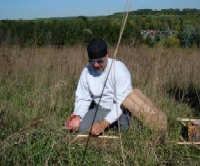Waste Leachate Applications at the Fenske Landfill

Sampling vegetation for metals analysis
Products:
Project Description:
The Michigan Department of Environmental Quality (MDEQ) assumed the responsibility for completing the closure and capping of the Fenske landfill (SE ¼ Section 12, T6N R13W, Ottawa County, Michigan) after the original owner and operator abandoned the property. The final capping was completed in the Fall of 2002, but during active landfill operation, substantial amounts of rainfall had infiltrated and the landfill continues to produce leachate that must be removed to prevent rupture of the landfill cover. To dispose of this leachate, the MDEQ contracted with DLZ Michigan, Inc. to develop a spray irrigation system to apply the leachate on the vegetated landfill cover. Because of the potential for groundwater contamination, soil contamination, and negative effects on vegetation, this type of leachate disposal needs to be carefully monitored both to evaluate its effectiveness and to insure that adverse environmental impacts do not occur (Shrive et al., 1994; Revel et al., 1999; Smith et al., 1999a; 1999b). The MDEQ conducted experimental leachate applications on site during the fall of 2001 and summer of 2002, without any apparent adverse effects on established vegetation. The MDEQ expanded this project in 2003 to an operational level and contracted with Grand Valley State University (GVSU) and the Annis Water Resources Institute (AWRI) to monitor the effects of leachate application on soil chemistry, solute leaching, and plant growth.
Between July and November, 2003, approximately 32 cm of leachate were applied to the irrigation plots. The leachate was high in conductivity, NH4-N, and total organic carbon (TOC), but low in metals and volatile organic compounds (VOCs), similar to many other municipal landfill leachates (Kjeldsen et al., 2002). At the end of the 2003 irrigation season, leachate application had no significant effects on surface or subsurface soil properties, but soil solution conductivity and concentrations of Cl, NO3-N, TOC, Ba, and Cu increased significantly on irrigation plots. Plant biomass on irrigated plots was over three times greater than on control plots as a result of high rates of N and water addition, similar to positive growth effects noted in several other studies (Cureton et al., 1991; Maurice et al., 1999; Revel et al., 1999). High rates of leachate application in 2003 produced elevated leaching losses of both water and solutes, especially Cl and NO3-N. To reduce the potential for leaching losses, we recommended timing leachate applications to match periods of greatest evapotranspirational demand (June-August). Based upon water balance calculations, we recommended that no more than 2.4 cm of leachate should be applied per irrigation date in any location, total leachate applied should not exceed 9.6 cm in any one spray area during an irrigation season, and spray heads should be rotated among several spray areas to distribute the leachate applied.
A major concern noted in 2003 was related to the increase in soil solution electrical conductivity on irrigation plots. At their peak, soil solution conductivities exceeded 4 mmhos/cm, a level at which growth of salt-sensitive vegetation may become inhibited (Munshower, 1993; Stephens et al., 2000; Bowman et al., 2002). While landfill cap vegetation responded positively to leachate application in 2003, it was uncertain whether this positive response would persist if high rates of leachate application continued and soil solution conductivities approached that of the leachate itself (5 to 6 mmhos/cm) during the growing season. Reduced rates of leachate application were recommended to maintain soil solution conductivities at levels that would not inhibit plant growth (e.g., Adarve et al., 1998; Bowman et al., 2002). Reduced rates of leachate application to each spray area also would substantially lower NH4-N deposition, further decreasing the propensity for the high rates of NO3-N losses observed in 2003. In response to these suggestions and concerns, the MDEQ and DLZ Michigan, Inc. established a set of three spray areas for each of the 14 spray heads on the landfill cap, and sequentially rotated weekly leachate applications among these spray areas during the 2004 irrigation season as recommended. This report summarizes the results of the monitoring study for the period January to December, 2004, focusing on the effects of leachate irrigation on soil and soil solution chemistry, solute leaching, and plant responses, and highlights the changes in irrigation effects observed between 2003 and 2004.
